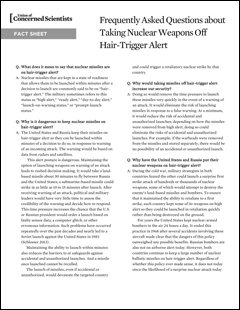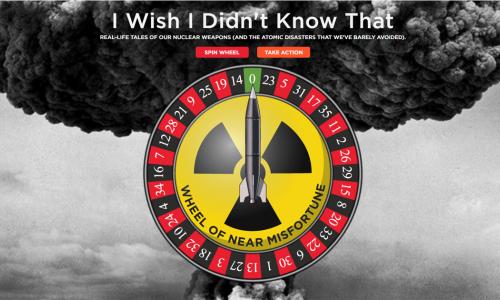Of the approximately 2,000 nuclear weapons currently deployed by the United States, nearly half are kept on hair-trigger alert. Originally intended to deter a Soviet first strike, weapons on hair-trigger alert can be launched within minutes if radar and satellite readings indicate a Russian attack. This increases the risk of an accidental or mistaken launch, with potentially catastrophic outcomes.
The Union of Concerned Scientists has compiled a list of frequently asked questions about hair-trigger alert and its implications for national security, with select questions and answers below. Download the fact sheet for the full FAQ, learn more about hair-trigger alert.
Q: What does it mean to say that nuclear missiles are on hair-trigger alert?
A: Nuclear missiles that are kept in a state of readiness that allows them to be launched within minutes after a decision to launch are commonly said to be on “hair-trigger alert.” The military sometimes refers to this status as “high alert,” “ready alert,” “day-to-day alert,” “launch-on-warning status,” or “prompt-launch status.”
Q: Why would taking missiles off hair- trigger alert increase our security?
A: Doing so would remove the time pressure to launch these missiles very quickly in the event of a warning of an attack. It would eliminate the risk of launching missiles in response to a false warning. At a minimum, it would reduce the risk of accidental and unauthorized launches; depending on how the missiles were removed from high alert, doing so could eliminate the risks of accidental and unauthorized launches. For example, if the warheads were removed from the missiles and stored separately, there would be no possibility of an accidental or unauthorized launch.
Q: How long would it take to launch a missile that is on hair-trigger alert?
A: U.S. land-based missiles can reportedly be launched within five minutes of a presidential decision to do so, and submarine-based missiles within 15 minutes (Kristensen and McKinzie 2012). Russian officials have stated that their land-based missiles can be launched within tens of seconds; it is not known whether that claim is an exaggeration or if Russian launch procedures allow faster launches than do U.S. procedures.
Q: How would the United States take missiles off hair-trigger alert?
A: Taking a missile off high alert so that it cannot be launched on a moment’s notice can be done in many different ways. The speed and ease of reversal would depend on the method used. For example, each U.S. missile silo has a safety switch that prevents the missile from being launched when maintenance workers are in the silo; flipping this switch to the “safe” position would remove the missile from hair-trigger alert. The silos are not staffed, so it would take a few hours for someone to travel to the silo, flip the switch to the on position, and return the missile to high alert. It could take up to a few days to return all U.S. land-based missiles to high alert. Another option is to remove the warheads from the missiles and store them separately, which would take much longer to reverse.
Download the fact sheet for the full FAQ.








